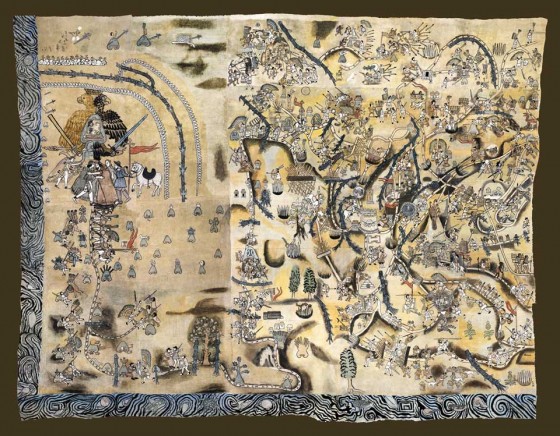The Quauhquechollan Canvas
A chronicle of conquest
written by Ana Lucía Ortiz & Pierina Piedra Santa
Its size is as great as its content is complex. The Lienzo de Quauhquechollan reveals to the viewer amazing feats of both the winners and losers in the conquest of Guatemala. This masterfully created canvas records many valuable details of an important event. Painted with natural pigments on cotton fabric around the year 1530, this critical artifact is considered to be the first map of the area. Graphically using footprints, hoofprints and glyphs, it shows the constant battle scenes of a cruel journey through the region that would later be called Quauhtemallan.
Decrypting the canvas was a complex and painstaking project, requiring many years of research. Heading the project was Dutch anthropologist Florine Asselbergs, and it was determined that it was not Pedro de Alvarado who single-handedly conquered the region as was previously believed, but by various conquerers (including his brother Jorge) during different stages along with many local allies.
The canvas is made up of 15 smaller pieces and measures 3.25 by 2.48 meters. It is estimated that it’s missing a third of its total size, cut from the right side. It’s also believed that this piece would tell of the conquest of eastern Guatemala, Honduras and El Salvador.
These were painted stories told by respected community story-tellers. The can-vas squares were place on the ground and “read” to groups of listeners.
The Quauhquecholteca only describe their successes, not their failures. The intention of the canvas is believed to have served as evidence to the Spanish crown to validate their request for the reward they were promised for their part in the conquest.
The University Francisco Marroquin, with the support of Banco G&T Continental, through its program Exploraciones sobre la Historia, has mounted a special exhibition of the Quauhquechollan canvas. The audience has the opportunity to meet with the past through technology. The original canvas was scanned and a group of specialists recreated it in all its clarity and color so that it appears as it must have looked in the 16th century. In addition, a visual narrative accompanies the exhibit in an entertaining and educational manner.
Exhibition information
Guatemala City:
Mon-Fri, 9am-4pm, Sat 9am-1pm. Centro Cultural de la Universidad Francisco Marroquin.Entrance Q30 / Q20 students & children. More info: www.lienzo.ufm.edu or call 2338-7959.
Quetzaltenango:
Mon-Fri 9am-5pm (until April 29) Centro Cultural de la Casa No’j, 7a calle 12-12, z. 1.Entrance free, full color catalog on sale for Q325. More info: call Licda. Claudia Mazariegos at 7768-3139.
